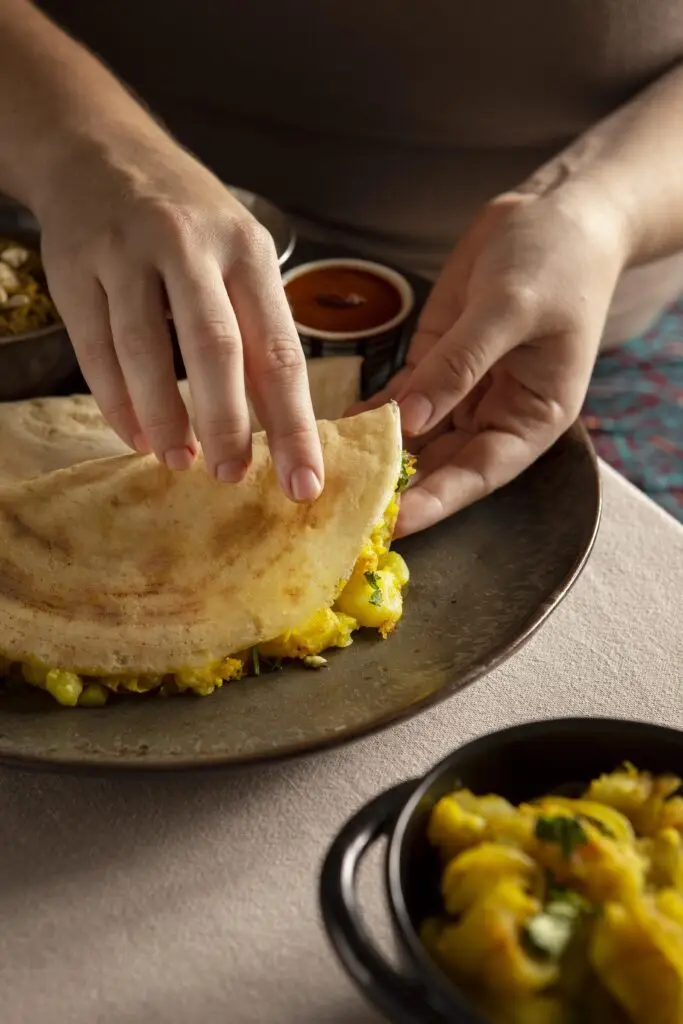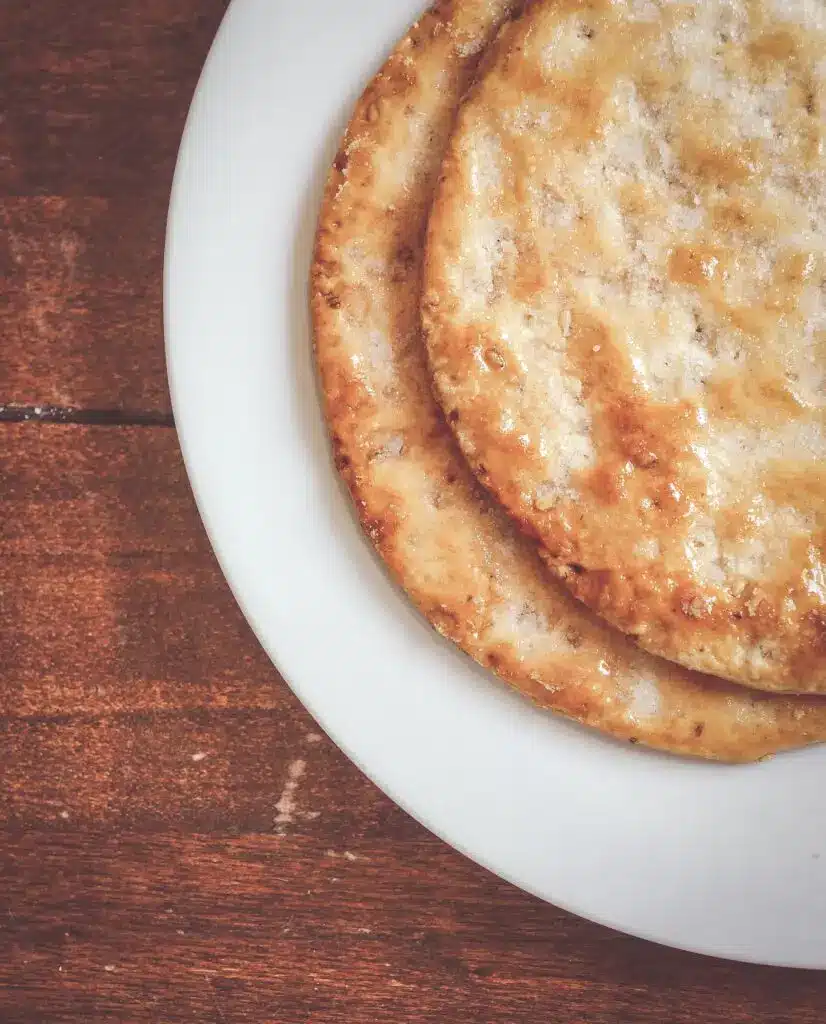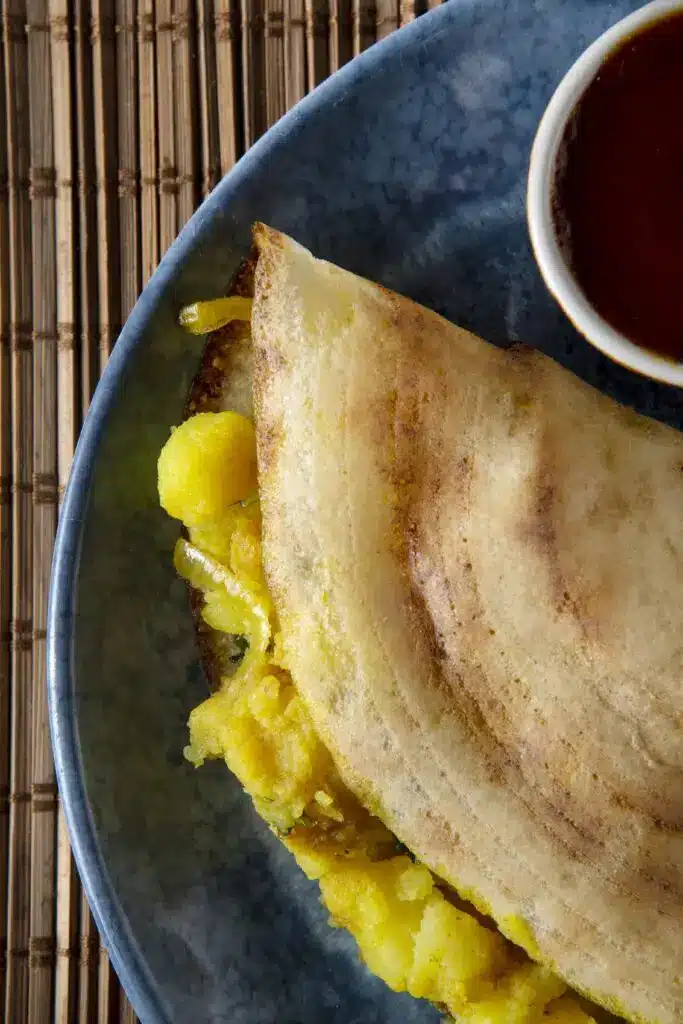Davangere Benne Dosa, a beloved dish from the town of Davangere in Karnataka, is known for its unique preparation and irresistible flavor. This dosa is a delightful combination of crispiness and buttery richness, thanks to the generous use of ghee. Served with coconut chutney and sambar, this dish makes for an excellent breakfast or snack. Whether you’re a fan of South Indian cuisine or new to it, Davangere Benne Dosa is sure to leave you craving more!


Ingredients:
For the Dosa Batter:
- 1 cup rice (preferably short-grain or regular rice)
- 1/4 cup urad dal (split black gram)
- 1/4 tsp fenugreek seeds (methi seeds)
- Water (for soaking and grinding)
- Salt (to taste)
For Serving:
- 2-3 tbsp ghee (clarified butter) or more, as needed
- Coconut chutney (optional)
- Sambar (optional)
Instructions:
1. Prepare the Dosa Batter:
- Soak the Ingredients: Start by soaking the rice, urad dal, and fenugreek seeds together in plenty of water. Let them soak for 6-8 hours, or overnight for best results. Soaking the ingredients is essential for proper fermentation and achieving the perfect dosa texture.
- Grind the Batter: After soaking, drain the water and transfer the rice, dal, and fenugreek seeds into a wet grinder or a high-powered blender. Add a small amount of water to help grind the ingredients. The goal is to achieve a smooth batter with a slightly thicker consistency than regular dosa batter.
- Fermentation: Once the batter is ground, transfer it to a large bowl and cover it with a lid or cloth. Allow The Batter To Rest in A Warm Spot For 8-12 Hours to ferment fully. If you’re making the dosa in colder weather, you can leave it in the oven with the light on to maintain warmth. Proper fermentation gives the dosa its characteristic flavor and texture.
2. Cook the Benne Dosa:
- Heat the Tawa or Griddle: Place a flat non-stick tawa (griddle) on medium heat. Allow it to become hot but not smoking. The right temperature is key to getting the dosa crispy on the outside and soft on the inside.
- Grease the Tawa: Lightly grease the tawa with a small amount of oil using a cloth or paper towel. You can also use a small dab of ghee for extra flavor.
- Spread the Batter: Once the tawa is heated, pour a ladleful of the batter onto the center of the tawa. Immediately spread it into a thin circle using the back of the ladle, in a gentle circular motion. The more thinly you spread the batter, the crispier your dosa will turn out.
- Add Ghee: Drizzle 1-2 tablespoons of ghee around the dosa edges. For the authentic Davangere Benne Dosa experience, don’t hesitate to add more ghee as it enhances the flavor and crispiness.
- Cook Until Golden and Crisp: Allow the dosa to cook for 2-3 minutes, or until the edges become golden brown and crisp. You’ll notice the dosa turning slightly golden and crispy around the edges, while the center remains soft.
- Fold and Serve: Once the dosa is cooked, gently fold it in half, or you can fold it into thirds, just like they do in Davangere. The crispy texture with a rich, buttery finish is what makes this dosa so irresistible.
3. Serve the Benne Dosa:
- Serve the hot, crispy Davangere Benne Dosa immediately with a side of coconut chutney and sambar for an authentic South Indian breakfast experience.
- If you prefer, you can also add a dollop of extra ghee on top of the dosa before serving for an even richer flavor.
Tips for the Perfect Benne Dosa:
- The Secret to Crispiness: The key to a perfect Benne Dosa lies in the generous use of ghee. This not only adds flavor but also contributes to the dosa’s signature crispy texture. Don’t skimp on the ghee while cooking the dosa.
- Fermentation: Proper fermentation is key to achieving a light, airy texture and rich flavor. Make sure to ferment the batter properly. If you’re in a hurry, using a fermenting agent or leaving the batter in a warm spot can speed up the process.
- Consistency of the Batter: The batter consistency should be balanced—not overly thick or too watery. If it’s too thick, the dosa will not spread easily, and if it’s too runny, the dosa may become soggy instead of crispy. Adjust the water accordingly while grinding.
- Griddle Temperature: Ensure the griddle or tawa is hot enough before spreading the batter. If the griddle is too cold, the dosa won’t crisp up, and if it’s too hot, the dosa might burn.
- Optional Additions: For an added twist, you can mix finely chopped onions, green chilies, or curry leaves into the batter before cooking. Some even like to stuff the dosa with spiced mashed potatoes for a masala dosa variation.
Serving Suggestions:
- Coconut Chutney: This is a must-have accompaniment for Davangere Benne Dosa. The creamy and mildly sweet coconut chutney pairs perfectly with the rich and crispy dosa.
- Sambar: A tangy and spicy lentil soup made with vegetables, sambar is a staple in South Indian meals and adds depth to the dosa experience.
- Chili Garlic Chutney: For those who prefer a spicier kick, try pairing the dosa with a chili garlic chutney made with red chilies, garlic, and tamarind.


Conclusion:
Davangere Benne Dosa is more than just a dish; it’s an experience. From its crispy texture to the rich, buttery taste, every bite takes you closer to the heart of Karnataka’s food culture. Whether you’re making it for breakfast, lunch, or dinner, this dosa will be a hit at the table, leaving everyone craving more. Enjoy it with coconut chutney, sambar, or any chutney of your choice for a fulfilling, mouthwatering meal.
How to Make Authentic Marwadi Dal Bati: A Complete Guide
What is Davangere Benne Dosa?
Davangere Benne Dosa is a popular South Indian dosa known for its crispy texture, rich buttery flavor, and served with coconut chutney or potato palya.
What ingredients are required to make Davangere Benne Dosa?
Key ingredients include rice, urad dal, poha (flattened rice), fenugreek seeds, salt, and butter.
How do I ferment the batter for Davangere Benne Dosa?
Soak rice, urad dal, poha, and fenugreek seeds, grind into a smooth batter, and let it ferment for 8-10 hours or overnight.
What makes Davangere Benne Dosa different from regular dosa?
The generous use of butter and a specific batter consistency give it a unique flavor and texture compared to regular dosa.
Can I use oil instead of butter?
To achieve the authentic taste, butter is recommended, but you can use ghee or oil as an alternative.
How to get the dosa crispy?
Ensure the batter consistency is not too thick, use a hot tawa, and spread the batter thinly. Cook on medium heat with enough butter for crispiness.
Can I store the batter?
you can refrigerate the batter for up to 3 days after fermentation.